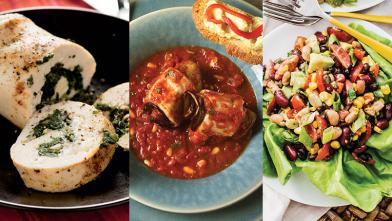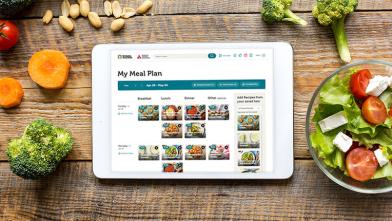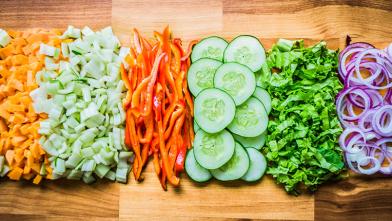The Mediterranean eating pattern is one of the suggested eating patterns that can be used to create your eating plan to manage diabetes. It uses whole, minimally processed ingredients rich in flavor and nutrients.
Types of Foods in the Mediterranean Eating Pattern
It’s more than just an eating pattern—it’s a lifestyle that focuses on:
- Seasonal vegetables and fruits
- These form the foundation of most meals
- Whole grains, such as whole wheat bread, bulgur, farro, and barley
- These provide quality carbohydrates and fiber
- Legumes like lentils, chickpeas, and beans
- These serve as nutrient-rich sources of plant-based protein
- Healthy fats, primarily from olive oil, nuts, and seeds
- These are a central part of meals, with minimal reliance on saturated fats
- Seafood and lean proteins, including fish and shellfish
- These are regularly featured
Red meat is rarely used and dairy products like yogurt and cheese are limited. Meals are often flavored with herbs and spices instead of salt.
Benefits of the Mediterranean Eating Pattern
Studies have shown this eating pattern can lower your risk of heart disease, improve cholesterol levels, and help with your metabolic health. Healthy fats, fiber, and lean proteins in the pattern support your dietary needs.
While the Mediterranean eating pattern can be used for your eating plan, some changes can make it even better for managing your blood glucose.
- Make non-starchy vegetables a focus: Incorporate more leafy greens, peppers, tomatoes, zucchini, cauliflower, and eggplant in meals.
- Swap out refined carbs: Choose whole grains instead of plain white bread, pasta, and rice. You will get more fiber and other nutrients
- Use high-fiber legumes: Beans, chickpeas, and lentils are nutrient-dense, plant-based proteins and higher fiber carbs.
- Choose lean proteins: Skinless chicken breast or turkey, fish, or plant-based proteins such as beans, lentils, nuts, nut butters, and seeds.
Remember to balance your carbs: Eat your carbs with lean protein and healthy fats to help slow digestion, which helps you manage blood glucose.
Recipes to Try
Here are a few Mediterranean recipes to try:
- Unstuffed Pepper Casserole: A staple of Mediterranean cuisine, bell peppers are often prepared with rice, ground meat, and herbs. Serve our recipe along with a side of steamed or grilled vegetables.
- Spicy Lentil Stew: A comforting and nutrient-rich dish made with lentils, onions, carrots, celery, red bell pepper, chicken broth, spicy chicken sausage and bay leaves.Pair with a leafy green salad and a small slice of whole- grain bread (15g carbs) for a balanced meal that remains within moderate carb limits.
- Roasted Fish with Vegetables: Try our mediterranean style Roasted Veggie Grain Bowl with Seared Tilapia and Herbed Yogurt Sauce for lunch or dinner. This bowl combines higher fiber quinoa with roasted veggies and a lean protein, tilapia.
- Black Bean & Quinoa Mason Jar Salad: A flavorful dish that can be prepared ahead of time as a grab and go mediterranean style lunch. This high fiber lunch is packed with veggies and plant based protein.
The Takeaway
The Mediterranean eating pattern offers a wealth of options that you can enjoy while managing your blood glucose.
Ready to start your Mediterranean cooking adventure? Be sure to check out all the recipes on Diabetes Food Hub and create an account so you can save recipes to try later. You can even create and print a grocery list to bring with you to the grocery store.














